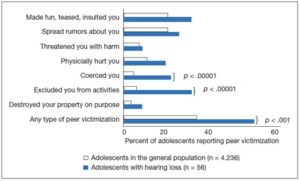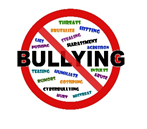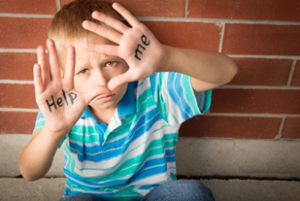Related Products
For Parents
Related Teacher Tools Takeout Items
Bullying / Teasing Happens!
 October is National Bullying Prevention Month.
October is National Bullying Prevention Month.
Gallaudet researchers found that 812 deaf and hard of hearing students in eleven U.S. schools reported instances of bullying at rates 2-3 times higher than reported by hearing students. It is obvious that bullying is a serious problem. What is not always so clear is how parents, teachers, and deaf/hard of hearing students can work together to resolve it.
The Problem:
The incidence of bullying in the deaf or hard of hearing student population is a significant, even startling, reality. A 2018 study1 found that adolescents with hearing loss endured significantly higher incidence of bullying versus the general population (50.0% vs. 28.0%), particularly for exclusion (26.3% vs. 4.7%) and coercion (17.5% vs. 3.6%). Children younger than 12 years with hearing loss reported lower rates of bullying (38.7%) than adolescents with HL, but rates did not differ significantly.
 “I thought more children and adolescents with hearing loss would report getting picked on, but I did not expect the rates to be twice as high as the general population,” said Dr. Andrea Warner-Czyz, study author.
“I thought more children and adolescents with hearing loss would report getting picked on, but I did not expect the rates to be twice as high as the general population,” said Dr. Andrea Warner-Czyz, study author.
In 20162, the story of a deaf high school student in Nebraska was reported on television news. Students had taken his backpack during a lunch period and dumped it in a toilet. Contained inside were his tablet, school supplies, homework, debit card, and his cochlear implant. The student, Alexis Hernandez, reported: “Those students think it’s ok to bully a deaf student, but it’s not. It’s not OK to bully someone who is disabled, deaf, or hard of hearing. Or anyone for that matter.”
Another study3 found that students who had lower language abilities were more vulnerable to victimization if they lacked understanding of their own emotions and levels of anger, sadness, and fear. As students with hearing loss have a greater risk for difficulty in being able to identify and describe emotional states4, recognizing that these challenges may contribute to victimization has important implications for intervention.
Bullying can be5:
- verbal: name-calling, insulting, teasing, ridiculing
- emotional/indirect: ignoring or deliberately excluding, spreading rumors or nasty stories, turning friends against the child, laughing at them or talking about them behind their back, taking, hiding or damaging their personal belongings, drawing unkind pictures of the child, using a feature of the child’s disability to bully them, e.g. deliberately making loud noises near a deaf child who is known to find loud noises unpleasant, creeping up on them from behind to scare them, deliberately making a noise when the teacher is giving instructions.
- physical: any physical contact which would hurt such as hitting, kicking, pinching, pushing, shoving, tripping up, pulling out hearing aids.
- manipulation/controlling behavior: using the child’s vulnerability as a way of controlling them or making them do something the bully wants them to do.
- cyberbullying: using electronic media (internet, mobile phones) to bully someone. This includes bullying through text messages, instant messaging, email, chat forums, online games and social networking websites.
Solutions:
Once we recognize what forms the behavior takes, what possible solutions are available for our students who are vulnerable?
Incorporate routine screening for bullying via direct questions6:
- 1. Ask the child about friends. A response of “none” or “few friends” deserves additional prompting (Why do you think that is?).
- 2. Inquire if the child avoids going to school and request more information on the assistance the child has accessed.
- 3. Ask the child directly if he or she has experienced bullying. If the child answers “yes,” ask follow-up questions and refer the child to school and community resources.
Address developing skills to reduce victimization in the student IEP6:
 Issues related to peer victimization can also be included on individualized education plans or 504 plans. For example, educational plans can specify informing teachers and classmates about hearing loss. Plans can also include a safe environment statement designating a “home base” where a student can go when feeling unsafe and/or a “safe person” with whom a student can discuss difficult situations. Additionally, education plans could include strategies to reduce vulnerability and improve response to bullying by targeting social pragmatic skills (e.g., taking turns and asking questions; reading facial expressions and body language) via one-on-one instruction, role playing, or social stories. Organizing a social skills group can help children develop social competencies in a supportive environment. Clinicians can also help patients address assertiveness and/or self-advocacy, with specific training to identify and report bullying, say “no” to stop the situation, and request assistance from a trusted source.
Issues related to peer victimization can also be included on individualized education plans or 504 plans. For example, educational plans can specify informing teachers and classmates about hearing loss. Plans can also include a safe environment statement designating a “home base” where a student can go when feeling unsafe and/or a “safe person” with whom a student can discuss difficult situations. Additionally, education plans could include strategies to reduce vulnerability and improve response to bullying by targeting social pragmatic skills (e.g., taking turns and asking questions; reading facial expressions and body language) via one-on-one instruction, role playing, or social stories. Organizing a social skills group can help children develop social competencies in a supportive environment. Clinicians can also help patients address assertiveness and/or self-advocacy, with specific training to identify and report bullying, say “no” to stop the situation, and request assistance from a trusted source.
For teachers: provide ongoing education to keep students aware that the bullying they may be experiencing – or doing to others – is unacceptable. Give your students a safe and open communication pathway for reporting incidents of bullying. Recognize that bullying will most often happen when you are not watching – In the lunchroom, the bathrooms, the playground, the hallways. Just because you did not see it does not mean it did not happen!
Be a listener. Be supportive. Report incidents to your school administration as promptly as possible.
For parents: talk to your child about feelings – openly and often. They need to know that when things go wrong, you will be there to support them. Stay closely involved with
school administrators and teachers. Does the staff understand about hearing loss? Really understand?
About cyberbullying: This form of bullying may be the most insidious and dangerous of all. While our deaf and hard of hearing students find invaluable and positive connections online, the potential for negative interactions has increased disproportionately.
How can we be proactive about cyberbullying? By being fully aware of what websites are being used. If we as adults continue to make excuses about our lack of skill or disdain for social media, we are inadvertently providing limitless opportunities for our children to be vulnerable to cyberbullying.
Recognize, React, and Raise Awareness
October month is dedicated to Bullying Prevention but teachers and parents of deaf and hard of hearing children are fully aware that the need to protect vulnerable students is ongoing. Find a wealth of resources to stop bullying in your family or classroom or school in the following websites.
Resources for Teachers and Parents
- http://www.nea.org/tools/lessons/teaching-students-to-prevent-bullying
- https://stompoutbullying.org/get-help/about-bullying-and-cyberbullying
- https://www.lebonheur.org/blogs/practical-parenting/keeping-up-with-your-child-online
- https://www.pacer.org/bullying/classroom/planet-fitness/
- Kraizer, S. (2007). 10 Days to a Bully-Proof Child. Marlowe & Co., New York. https://www.amazon.com/10-Days-Bully-Proof-Child-Confidence/dp/1569242534
References
- 1. Warner-Czyz, A. D., et. al. (2018) Effect of hearing loss on peer victimization in school-age children. Exceptional Children. https://medicalxpress.com/news/2018-04-children-loss-bullying.html . Download from: https://successforkidswithhearingloss.com/wp-content/uploads/2019/09/Children-with-hearing-loss-face-more-bullying-2018.pdf
- 2. 2016 news: https://www.newschannel5.com/news/national/burke-high-school-investigating-bullying-incident-after-it-goes-viral
- 3. Van den Bedem, N.P., et al, (2018). Victimization, bullying, and emotional competence: Longitudinal associations in (Pre)Adolescents with and without developmental language disorder, Journal of Speech, Language, and Hearing Research, 61, 2028-2044.
- 4. Goberis, D., Beams, D., Daples, M., Abrisch, A., Baca, R. & Yoshinaga-Itano, C. (2012). The Missing Link in Language Development of Deaf and Hard of Hearing Children: Pragmatic language development. Seminars in Speech and Language, (2012), 33:4, 297-309.
- 5. Bullying Advice for Parents of Deaf Children. National Deaf Children Society in the UK. Download from: https://successforkidswithhearingloss.com/wp-content/uploads/2019/09/Bullying-Advice-for-Parents-of-Deaf-Children-NDCS-UK.pdf
- 6. Warner-Czyz, A. D. (2018). Peer victimization of children with hearing loss. The Hearing Journal, October. Download from: https://successforkidswithhearingloss.com/wp-content/uploads/2019/09/Peer_Victimization_of_Children_with_Hearing_Loss.4.pdf



